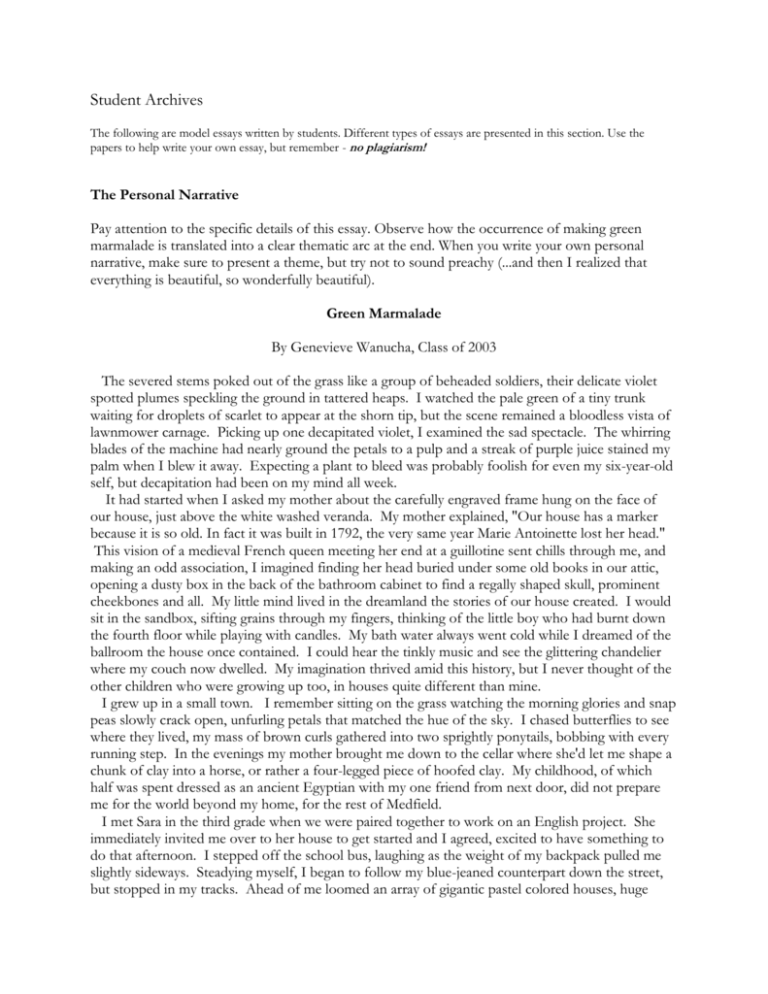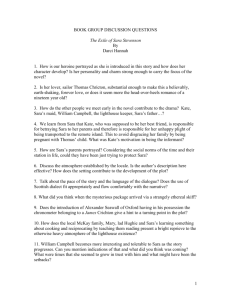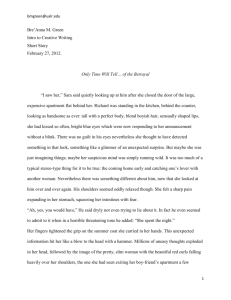Genevieve Wanucha Sample Writing
advertisement

Student Archives The following are model essays written by students. Different types of essays are presented in this section. Use the papers to help write your own essay, but remember - no plagiarism! The Personal Narrative Pay attention to the specific details of this essay. Observe how the occurrence of making green marmalade is translated into a clear thematic arc at the end. When you write your own personal narrative, make sure to present a theme, but try not to sound preachy (...and then I realized that everything is beautiful, so wonderfully beautiful). Green Marmalade By Genevieve Wanucha, Class of 2003 The severed stems poked out of the grass like a group of beheaded soldiers, their delicate violet spotted plumes speckling the ground in tattered heaps. I watched the pale green of a tiny trunk waiting for droplets of scarlet to appear at the shorn tip, but the scene remained a bloodless vista of lawnmower carnage. Picking up one decapitated violet, I examined the sad spectacle. The whirring blades of the machine had nearly ground the petals to a pulp and a streak of purple juice stained my palm when I blew it away. Expecting a plant to bleed was probably foolish for even my six-year-old self, but decapitation had been on my mind all week. It had started when I asked my mother about the carefully engraved frame hung on the face of our house, just above the white washed veranda. My mother explained, "Our house has a marker because it is so old. In fact it was built in 1792, the very same year Marie Antoinette lost her head." This vision of a medieval French queen meeting her end at a guillotine sent chills through me, and making an odd association, I imagined finding her head buried under some old books in our attic, opening a dusty box in the back of the bathroom cabinet to find a regally shaped skull, prominent cheekbones and all. My little mind lived in the dreamland the stories of our house created. I would sit in the sandbox, sifting grains through my fingers, thinking of the little boy who had burnt down the fourth floor while playing with candles. My bath water always went cold while I dreamed of the ballroom the house once contained. I could hear the tinkly music and see the glittering chandelier where my couch now dwelled. My imagination thrived amid this history, but I never thought of the other children who were growing up too, in houses quite different than mine. I grew up in a small town. I remember sitting on the grass watching the morning glories and snap peas slowly crack open, unfurling petals that matched the hue of the sky. I chased butterflies to see where they lived, my mass of brown curls gathered into two sprightly ponytails, bobbing with every running step. In the evenings my mother brought me down to the cellar where she'd let me shape a chunk of clay into a horse, or rather a four-legged piece of hoofed clay. My childhood, of which half was spent dressed as an ancient Egyptian with my one friend from next door, did not prepare me for the world beyond my home, for the rest of Medfield. I met Sara in the third grade when we were paired together to work on an English project. She immediately invited me over to her house to get started and I agreed, excited to have something to do that afternoon. I stepped off the school bus, laughing as the weight of my backpack pulled me slightly sideways. Steadying myself, I began to follow my blue-jeaned counterpart down the street, but stopped in my tracks. Ahead of me loomed an array of gigantic pastel colored houses, huge square-headed giants with window-like eyes, long, red, open mouths with miniscule doorknocker noses. I felt out of place, like the bus had dropped me off in the land of the "huge and shiny," where the brand-new asphalt paved the road as far as the eye could see, veering off to form numerous three-car driveways. "What's wrong with you?" called my new friend. "Let's go!" She grasped my arm and dragged me up the road. A dismal picture of my own house filled my head. My house, I thought, could fit into one of these garages. Dragging my increasingly heavy feet, I wondered which of these massive structures I would get to enter. They all seemed identical, save the color. We passed the pale blue house with the cream shutters, the rosebud pink one with the mauve trimming, finally stopping in front of a peach castle complete with a brown and white marbled walkway leading up to the front door. "Your house is beautiful," I breathed, trying not to sound too impressed. My friend brushed off the compliment, "Oh, well once we get the pool installed, it'll be so much better." I silently prayed Sara would never ask to come over. Inside we went and, as I expected, found cleanly polished floors and imposing oriental-rugged staircases. The ceilings stretched to eternity; I felt tiny in the spacious interior of the house. Cringing at the mental picture of the narrow hallways of my house, choked with overflowing bookcases, I followed Sara to the kitchen to have a snack. I swallowed my intimidation as I sat down at the smooth marble countertop and watched the refrigerator door spit out perfect ice crescents into a cup. As the day wore on I became accustomed to the luxury. I put the feelings of intimidation away and worked on the project until my mother came to pick me up. I made the mistake of stopping in the bathroom on the way out. Washing my hands, I gazed at the golden faucets. The clean metal was not fingerprinted; there were not strands of hair in the sink or between the tiles, no rips in the wallpaper, no foggy areas on the mirror. Then it struck me: The uncomfortable feeling I'd felt nagging on me since I walked in the house. I was ashamed of where I lived. "Mom, are we poor?" The question just slipped out of my mouth. To the best of my third grade comprehension I knew that money was the main difference between my house and Sara's. At that moment it seemed important. I saw the hurt expression on my mother's face and immediately regretted opening my mouth. "No, we're in the middle, not rich, but certainly not poor." I barely listened to her answer, thinking of the way she always made sure the house looked clean before guests came over, how she had painted a mural on the living room walls. I decided that I did not care about money, but the devastating differences between the houses nevertheless caused me shame. From then on, I went to extremes to not invite my friends over. When Sara asked if we could work on the project at my house, I made up stories about a contagiously sick sister or kitchen construction. One day as our English project was nearing completion, we decided to supplement the poster with something edible, something that would whisk our classmates off to Victorian England, the subject of our endeavors. We decided on marmalade and toast. It was my idea to hand-make the marmalade. Growing up in my family, inventive cooking had always been a regular event. My mother encouraged me to make up or add to recipes, so that sunny day in Sara's perfectly marbled kitchen, I did what I knew best. "Hey," I urged Sara, "Everyone knows what plain old orange marmalade is, but I bet no one has ever heard of green marmalade. Do you have any limes?" And so we began, boiling sugar, peeling limes, following the recipe I had "memorized." We worked hours on this concoction, pouring in cup upon cup of sugar, using nearly a whole bag of Florida limes. The stainless steel sink bulged with sticky saucepans and spoons. The counter tops were covered in granules of sugar and drips of limejuice. Finally, some semblance of my busy kitchen appeared. The substance actually became jelly-like, but unfortunately, the green I was going for had turned into a dull brown. Disgusted at the inability of the limes to retain their greenness, I poured half a bottle of green food coloring into the pan, glazing the stovetop and floor with a delicate spray of green mist. Sara's mother came home then, and instead of being impressed that two third graders had invented the new shade of marmalade, as I would expect, she spat with rage. The blood crept slowly into her cheeks, the grocery bags were squeezed as she decided what to yell about first. "What on earth is going on in my kitchen?" she wailed, "My tiles………." Needless to say, getting green splotches on mahogany cabinets was not my brightest idea, but it made me think about how that experience would have been different at my house. My mother would probably have helped us and a mess would not have hurt anything. Sara's mother sent me out of the house fuming with my "waste of expensive ingredients" in a Tupperware. I was fuming too, upset by how my life seemed not to fit at all into this modern and luxurious environment. As I left I passed a potted plant on a table. I bitterly imagined knocking the plant over, sending the dirt to be ground into the carpet for weeks. I approached the plant but soon discovered that the leaves were fabric, the stems stuck in artificial green sponge. I belonged in my home. My house welcomed my plant collection; there were ferns and magenta orchids hanging over the coffee pot. Animals roamed my house, sleeping on the furniture, eating off our plates. I could make a mess in the kitchen and not have to replace marble tiles in the process. I realized that day as I stormed out of the house, with my "waste of expensive ingredients," that my home had cultivated my creativity, personality, and idea of freedom of expression. From that moment forward, I have ached for another environment where unrestrained artistic expression is welcome, where the air smells of home.





